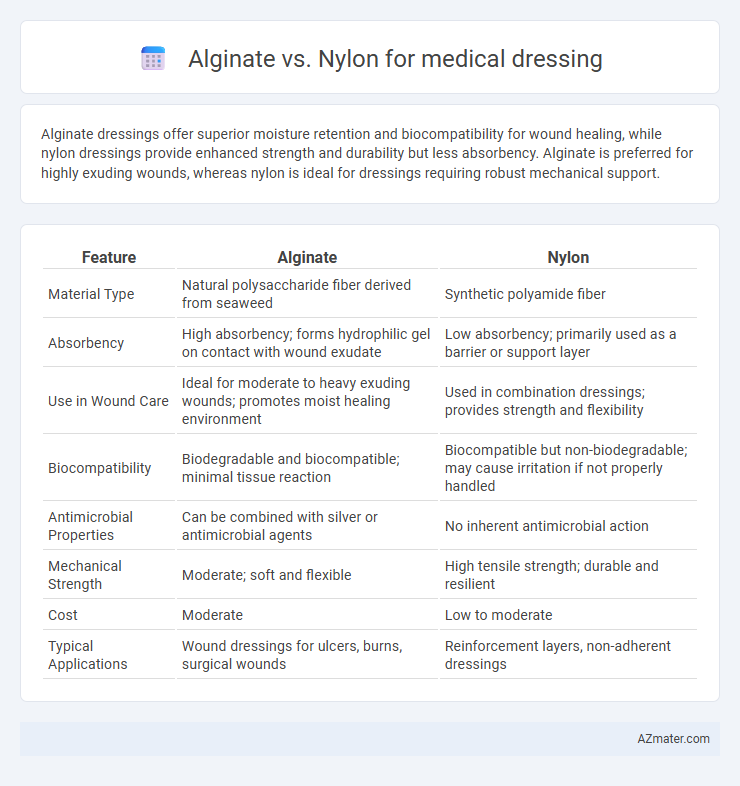Alginate dressings offer superior moisture retention and biocompatibility for wound healing, while nylon dressings provide enhanced strength and durability but less absorbency. Alginate is preferred for highly exuding wounds, whereas nylon is ideal for dressings requiring robust mechanical support.
Table of Comparison
| Feature | Alginate | Nylon |
|---|---|---|
| Material Type | Natural polysaccharide fiber derived from seaweed | Synthetic polyamide fiber |
| Absorbency | High absorbency; forms hydrophilic gel on contact with wound exudate | Low absorbency; primarily used as a barrier or support layer |
| Use in Wound Care | Ideal for moderate to heavy exuding wounds; promotes moist healing environment | Used in combination dressings; provides strength and flexibility |
| Biocompatibility | Biodegradable and biocompatible; minimal tissue reaction | Biocompatible but non-biodegradable; may cause irritation if not properly handled |
| Antimicrobial Properties | Can be combined with silver or antimicrobial agents | No inherent antimicrobial action |
| Mechanical Strength | Moderate; soft and flexible | High tensile strength; durable and resilient |
| Cost | Moderate | Low to moderate |
| Typical Applications | Wound dressings for ulcers, burns, surgical wounds | Reinforcement layers, non-adherent dressings |
Introduction to Medical Dressing Materials
Alginate and nylon are prominent materials used in medical dressings, each offering distinct properties suited for wound care. Alginate, derived from seaweed, is highly absorbent and promotes a moist healing environment by forming a gel upon contact with wound exudate, making it ideal for moderate to heavily exuding wounds. Nylon, a synthetic polymer, provides strength and flexibility, often used as a backing or mesh in dressings to secure and protect the wound while allowing breathability.
Overview of Alginate Dressings
Alginate dressings, derived from brown seaweed, are highly absorbent and ideal for managing moderate to heavy exudate in medical wounds. Their unique gel-forming capability upon contact with wound fluids promotes a moist healing environment and facilitates autolytic debridement. Compared to nylon dressings, alginate dressings offer superior biocompatibility, enhanced healing rates, and are particularly effective for infected or deep cavity wounds.
Overview of Nylon Dressings
Nylon dressings in medical applications offer high tensile strength, flexibility, and durability, making them suitable for wound care requiring secure and long-lasting coverage. These dressings are non-absorbent, promoting a protective barrier that helps prevent external contamination while allowing breathability to support the healing process. Their smooth texture reduces irritation and facilitates painless removal, essential for sensitive or fragile skin conditions.
Key Differences Between Alginate and Nylon
Alginate dressings are derived from seaweed and excel in absorbing high amounts of wound exudate, promoting moist wound healing and aiding in tissue regeneration. Nylon dressings, made from synthetic fibers, offer superior tensile strength and durability but have limited absorbency compared to alginate. Alginate is best suited for moderate to heavily exuding wounds, while nylon dressings provide structural support and are often used as secondary dressings or sutures.
Absorption Capabilities: Alginate vs Nylon
Alginate dressings exhibit superior absorption capabilities due to their natural hydrophilic properties, enabling them to absorb 15-20 times their weight in fluid, making them ideal for moderate to heavily exuding wounds. In contrast, Nylon dressings offer limited absorption as synthetic fibers that primarily provide structural support rather than fluid management. Effective wound care often prioritizes alginate for highly exudative wounds, while nylon serves better in low-exudate scenarios requiring durability.
Biocompatibility and Safety in Wound Care
Alginate dressings, derived from seaweed, exhibit high biocompatibility and are particularly effective in managing exuding wounds due to their superior absorption and gentle interaction with tissue, minimizing irritation and promoting a moist healing environment. Nylon dressings, while durable and flexible, may pose a higher risk of tissue adherence and irritation, potentially disrupting delicate wound beds and delaying healing. Clinical studies emphasize alginate's safety profile in reducing infection rates and enhancing patient comfort, making it a preferred choice in wound care for sensitive skin and compromised tissue.
Antimicrobial Properties Compared
Alginate dressings, derived from seaweed, inherently promote a moist environment that facilitates natural antimicrobial action through the release of calcium ions, aiding in wound healing and infection control. Nylon dressings, while durable and breathable, lack intrinsic antimicrobial properties and often require coating with antimicrobial agents to prevent microbial growth. Clinical studies indicate alginate dressings exhibit superior efficacy in reducing bacterial load in chronic wounds compared to unmodified nylon counterparts.
Applications and Use Cases in Clinical Settings
Alginate dressings, derived from seaweed, excel in managing moderate to heavy exudate wounds such as pressure ulcers, diabetic foot ulcers, and surgical sites by promoting a moist healing environment and supporting autolytic debridement. Nylon dressings, known for their durability and non-reactive properties, are often utilized in areas requiring strong adhesion and flexibility, such as securing intravenous lines and protecting incisions in high-movement regions. Clinical use favors alginate for highly exuding wounds due to its superior absorbency and hemostatic capabilities, while nylon dressings are preferred for applications demanding prolonged wear and minimal skin irritation.
Cost-Effectiveness and Accessibility
Alginate dressings offer superior cost-effectiveness in medical wound care due to their high absorbency and ability to promote faster healing, reducing the frequency of dressing changes and overall treatment costs. Nylon dressings, while durable and flexible, tend to be more expensive and less accessible in low-resource settings because they require specialized manufacturing processes. The widespread availability and affordability of alginate make it a preferred choice in many healthcare systems aiming for efficient wound management.
Conclusion: Choosing the Right Dressing Material
Alginate dressings offer superior absorbency and promote moist wound healing, making them ideal for wounds with heavy exudate. Nylon dressings provide durability and flexibility but lack the high absorption capacity required for complex wound care. Selecting the right dressing material depends on wound type, exudate level, and healing stage to ensure optimal recovery.

Infographic: Alginate vs Nylon for Medical dressing
 azmater.com
azmater.com